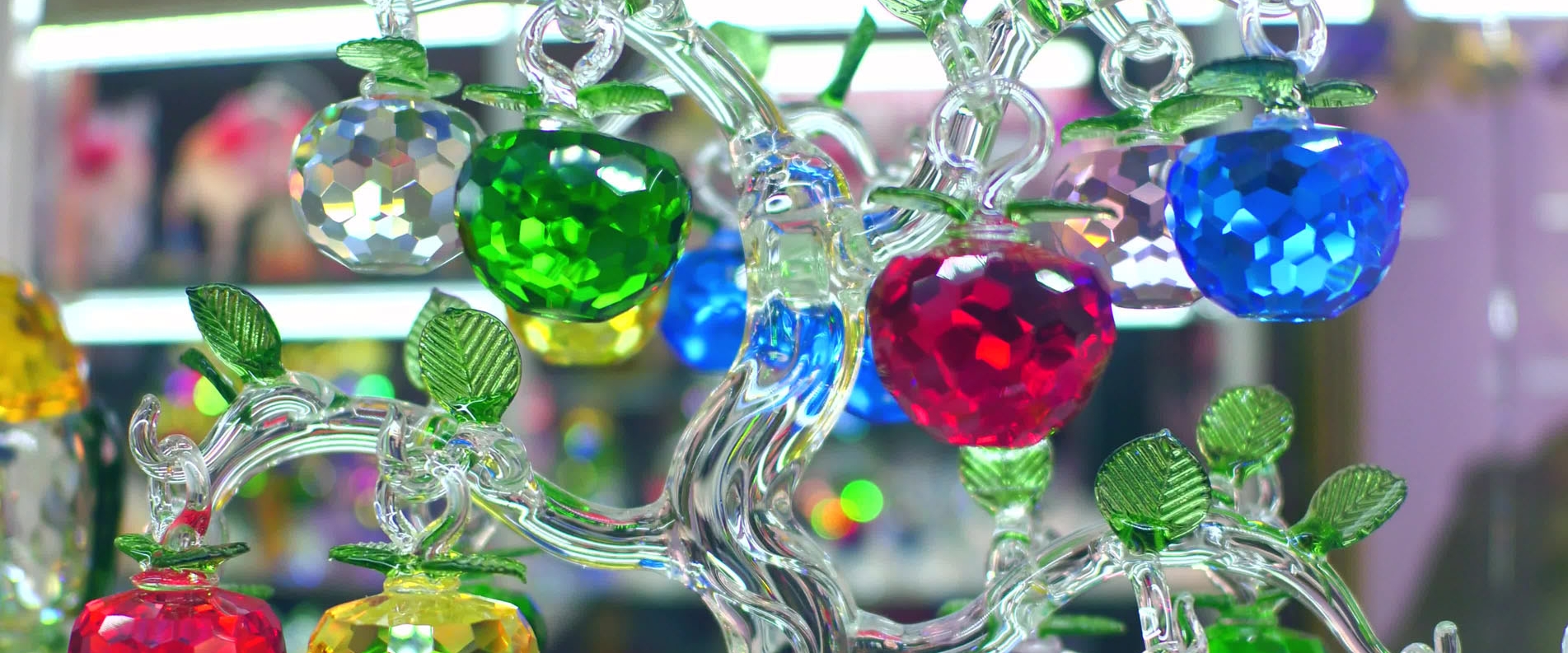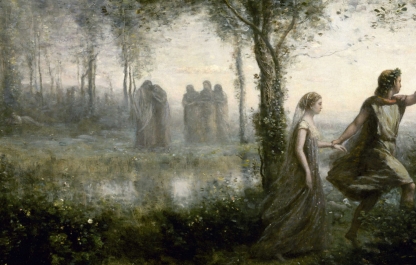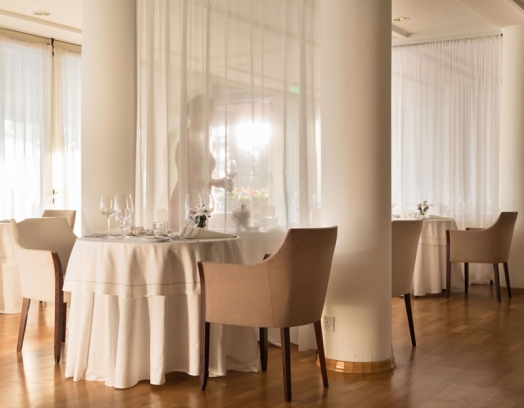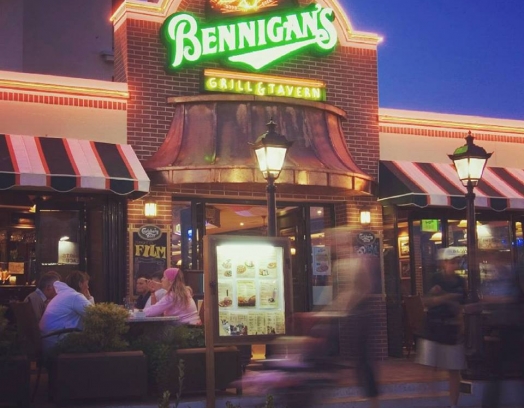Glass manufacture, like many other crafts discussed here, is a practice with a long existing history. Although it emerged approximately 5,500 years ago, there is still no single opinion with regards to where it first originated.
Glass appeared in Cyprus around 7-6 BC. Since then, the methods used in both industrial and amateur production have considerably improved, applying the same technology and principles which were used far into ancient times. Today, various items of glassware have found use in many spheres of the modern life of man: from industrial (glass containers, insulators, fibre protection and lenses) to decorative items and even monumental art (soft plastic, decorations, murals, stained-glass windows, glass art installations and sculptures).
For the most patient and interested of people, our master class awaits.
The History of Glass
Nowadays there is a widespread opinion that glass first appeared in the history of man in Mesopotamia, although until recent times, the main centre where glassware originated was acknowledged as Ancient Egypt.
So, archaeological sources testify to artificial glass first being produced on the coast of Syria: where the kingdom of Akkad once existed (2400-2200 BC). In the region of Ashnunaka, a cylindrical stamp [1] was discovered made of transparent, green-like glass (9mm in diameter), the age of which was calculated as close to 4,500 years old.
In times of old, scientists were aware that as well as the famous dark-green beaded necklace of the Empress Hatshepsut, the cladding on the inner chambers of the pyramid of Djoser (relating to 2700 BC) was made from faience slabs covered in an ancient Egyptian [2] glass glaze.
Yet still: a large part of the most ancient glass items preserved were found specifically in Egypt (most often blue in colour — with a touch of copper, or green — with copper and iron impurities) Amongst other things, glass balls were most often found: they may have appeared by themselves in the process of metal or pottery manufacture. Several findings have allowed us to make the assumption that part of them were most likely brought here from other regions.
-
Glass was manufactured in ancient times by using unrefined natural materials — sand, soda, ash and various low grade ores. As a result, the glass often proved to be cloudy and had an abundance of impurities: after cooling, the mass often had a yellowy-green or slightly light blue shade. In the late bronze era (the start of 2000 BC - 12 BC) both in Ancient Egypt and Western Asia, a powerful leap was made in the technology of glass manufacture: ingots and coloured glass vessels were amongst the archaeological findings of this period. Glass items dating back to 2000 BC were also discovered in India, Korea and Japan. For instance, in 5-3 BC China, glass items were appearing in large quantities and possessed a particular chemical composition. The very earliest references to this were from the end of 3 BC, where namely the manufacture of five-coloured glass was mentioned.
Since ancient times, in order to produce any type of glass (except quartz glass) three fundamental components have always been necessary: quartz sand, limestone and soda. Thus, in Egyptian and Syrian glass, craftsmen used soda obtained from the coal of many types of wood — this was often from halophile plants growing on the coast (wormwood, immortelle and tamarisk).
The earliest form of vessels were produced by rotating heated — and therefore pliant — glass fibres around a “model” made from sand and clay and then forced onto a metallic rod. After this, the resulting folded glass bundles were repeatedly heated and then fused into an integrated vessel. Skilled artisans were able to place coloured glass fibres on top of the finished product, as a means of decoration. The mould was then destroyed and the rod was removed from the new vessel. You can find out more and see some “real-life” samples of these works at The Museum of Cyprus.
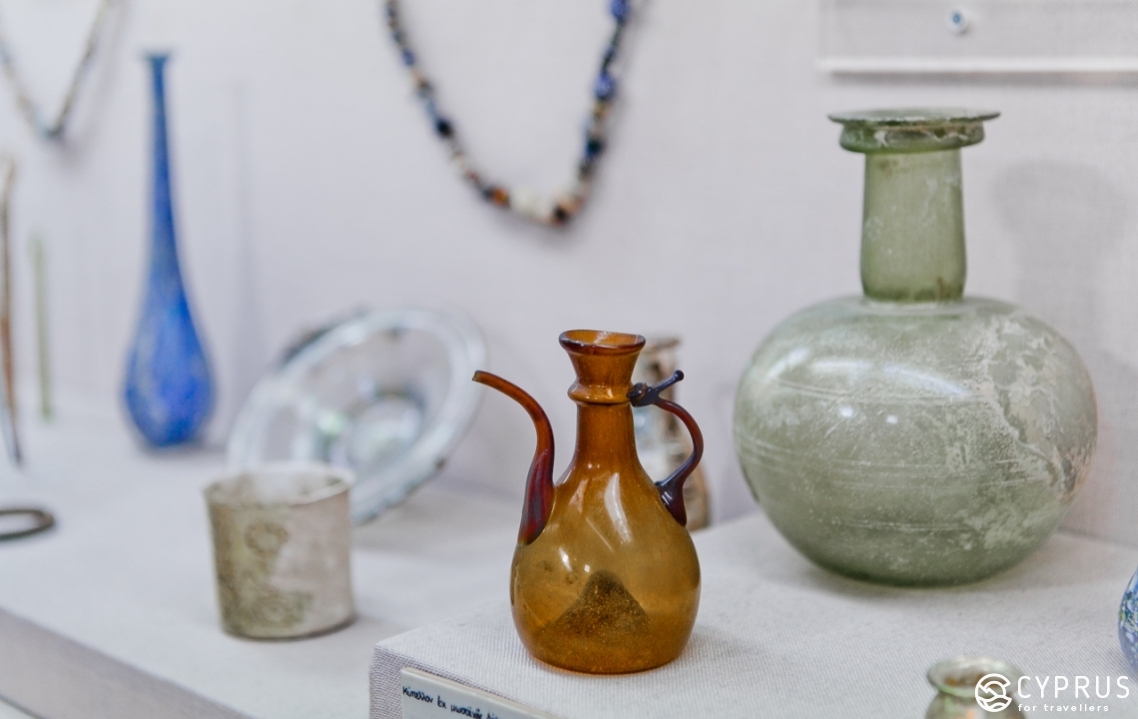
In addition to Egypt, by 15th century BC, glass — in royal workshops — had started to be produced en masse not only in the countries of Western Asia, but also in Crete. Countries located in remote regions either produced glass products from ready-made slabs (items cut from blocks) or the glass was preset into its model form. As you know, this material and the products manufactured from it continued to remain an item of luxury for the elite… In 9 BC, when the process of glass-making was revived in Syria and Cyprus, new additions had been made to the previous forms of technology — people had learnt to manufacture pure, colourless glass.
Interestingly, artisans didn’t only pass on their experience to apprentices via conversing with them, but written “instructions” and “aids” on glass manufacture also began to appear. The first of the most well known texts are the tables from the library of the Assyrian King Ashurbanipal (669-627 BC), dating back to 650 BC.
However, in Egypt, it was a long time before glass manufacture experienced its rebirth, which didn’t occur until the Greeks brought it with them under Ptolemaic rule in 4-1 BC — the Hellenistic era.
Thus, the technology of glass making underwent its greatest development in those years: not only did this period see the appearance of “mosaic” structures (made from a combination of multi-coloured glass) but also of products which were greater in size than former models; tableware was being made from glass. It was in this period specifically that colourless glass (without any impurities) began to be valued far greater than its coloured counter-type. The Roman Empire, with the introduction of its new technology, began to produce glass using a special type of sand — white quartz, considered as the purest form — from the beaches of the Eastern Mediterranean. In the countries of the Levant, namely Syria and Palestine, glass production was also actively developing, in the period branded as “the spirit of the times”.
It was the Romans in particular who invented the technique of glass-blowing (close to 30 BC, granting items the desired shape and size. The fact was they were no longer melting glass on bonfires, but in stone furnaces designed for melting (glass furnaces appeared in Rome under Gaius Julius Caesar (100-44 BC)).
It soon became clear that glass could be used to rather quickly manufacture almost any item with a desired size, shape and colour. Under the reign of Titus Vespasian (9-79 AD) sheet window glass was already being used (only in cathedrals) as well as glass plating for wall faces.
After the fall of the Roman Empire (at the end of 5 A.D) the centre of glass manufacture transferred to Byzantium, where artisans mastered the technique of melting coloured opaque glass (smalt) for mosaic works, instead of using stone. The year 686 is considered as the time when the first stained glass windows were created.
In Europe, glass only became sought after in the modern ages: it was used both in everyday and ecclesiastical architecture for manufacturing stained glass windows.
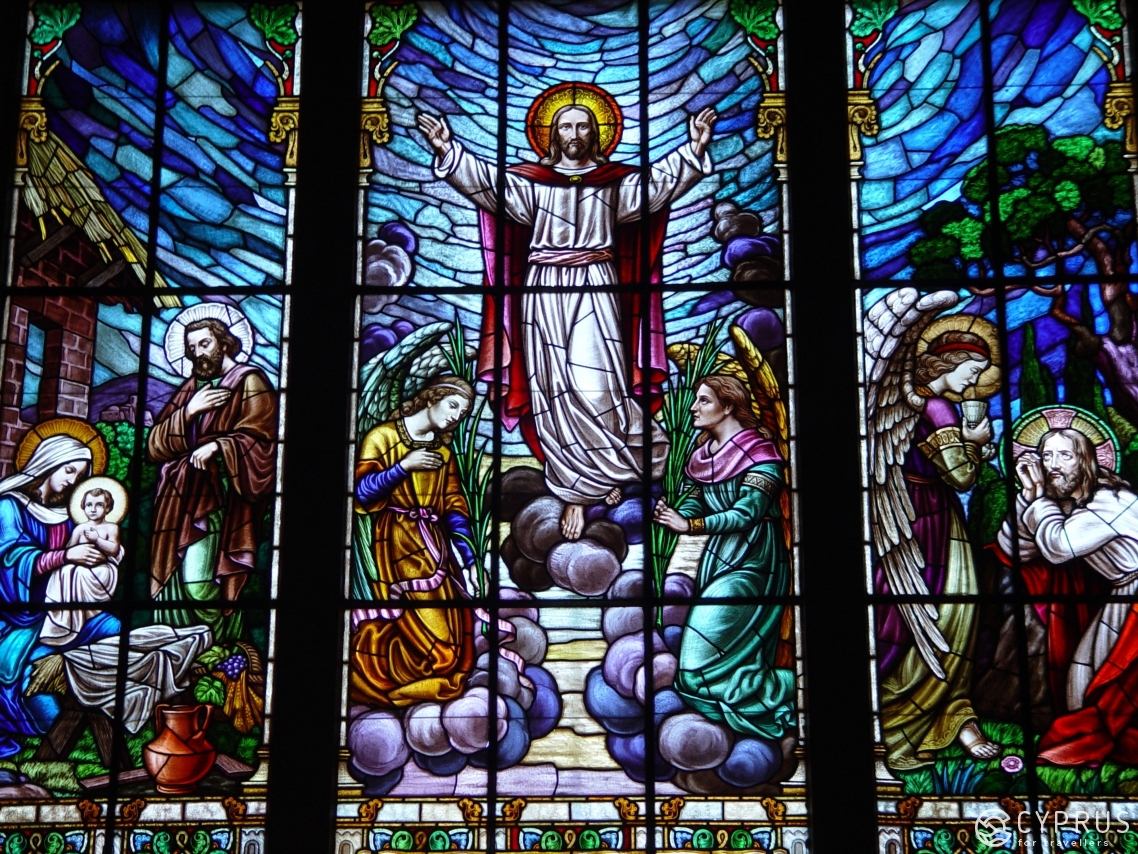
In Kievan Rus, as the results of excavations testify, the secret to glass production existed for more than a thousand years, while from 11 A.D. glass manufacture became widely developed, not just for serving the population’s everyday needs, but also as works of applied art and even luxury items. Multiple workshops opened where jewellery was created for the fashionistas of that time, such as glass beads, necklaces and bracelets.
Meanwhile German, and a little later, in the 13th century — Italian workshops, mastered the so called “halyava” (freebie) method of producing sheet glass, which was not only used for glazing churches and monasteries, but also the castles of the nobility. А “Halyava” was a cylindrical vessel blown by glass blowers in several stages. Then, while the glass was still pliant, the “halyava” was cut apart and straightened into a rectangular sheet. Although the quality of such a sheet left something to be desired, the glass practically matched the chemical composition of modern window panes.
-
Yet the acknowledged leader and trendsetter in the history of European glass-making and its development was, of course, Venice. The 13th century became a key moment in the history of Venetian glass. Former household items did not differ in any way from the glass produced in other European countries and had no artistic value.
However, once the Venetians had brought samples of Byzantine art glass from Constantinople, and more importantly, the recipe for its manufacture — this gave a push for the development of new technology. By the end of the 13th century, glass workshops which had gradually emerged in Venice itself were moved to the separate island of Murano, due to the high danger of fire which they posed. In the 14th-15th century, Murano became the centre for production and contributed to the island flourishing. Contemporaries were shocked by the sheer transparency of Venetian glass, as well as its richness and the diversity of paints and decorative elements used in its manufacture.
At the same time, the standards for manufacturing glass items were also developed.
Naturally, the secrets to mastering the manufacture of original glass were held very close to the chest by Italian entrepreneurs, — after all, in those times, local production was already highly valued over the whole world. Since then the reputation of coloured Venetian glass from Murano has only grown and is nowadays still highly valued not only in Europe, but also worldwide.
However, in the 17th century, a couple of centuries later, though Murano glass was in fashion, the Europeans had already diverted their attention to diamond glass. This type was from the Czech Republic, which having adapted the technique of glass making from other countries, had quickly learnt to melt their own pure, durable and heat resistant (sodium-calcium silicate) glass, — more widely known as “Bohemia crystal”.
Russian glass factories appeared during the reign of Alexey Mikhailovich (1629-1676): one of the first was built in 1635 under Mozhaisk by the Swedish entrepreneur Julius Koet.
In the last third of the century, the English had already begun trading globally, thanks to the invention of George Ravencroft in 1674, who had discovered a new means of producing crystal: he decided to replace the potash (potassium salt) with a concentrated lead oxide, resulting in glass with high reflective properties, which was highly responsive to cutting and engraving…
The 18th century saw the entrance of French troops into Venice. Glass factories were closing due to recognised artisans leaving the country and old technology being wasted.
In Moscow of the same century, state glass factories were erected in the Russian Empire under Emperor Peter I (1672-1725).
Mikhail Vasilyevich Lomonosov (1711-1765), a world renowned Russian scientist, natural philosopher, chemist, physicist and encyclopedist, founded the field of research into glass and its production. From 1748, he conducted the first technologically systematised crafting of glass and manufactured more than 4,000 pieces. The laboratory procedures and methods which he followed at that time barely differ from contemporary practices.
-
The renaissance of European glass production began only in the middle of the 19th century thanks to the Italian mosaicist Antonio Salviati (1816-1890). On the time-honoured Murano, in 1860, he founded a mosaic factory, which was reputed for its cheapness and the superb quality of its products.
Salviati soon after kickstarted the launch of thin-walled crockery, imitating classical Venetian glass.
-
At the end of the 19th century, artisan glassmaking had escalated to a level of mass production in industry. In 1905, the Belgian engineer Furko invented a method of extracting a glass sheet of a given width out of a furnace from a vertical position; this was perfected a century later by another Belgian — Emile Bishuera (1914). He suggested passing the glass between two rollers, which then greatly simplified the process of further processing the sheet, making it more level and therefore convenient for utilisation.
Forty years later, Sir Alistair Pilkington (1920-1995), another British researcher, developed the so-called “float” method of creating glass. This allowed the melted mass from the furnace to be passed, in the form of a flat ribbon, through a chamber of molten tin for subsequent cooling and annealing.
The resulting glass was distinguished by the stable thickness of the sheet, the absence of optical defects and a very high surface quality.
-
You will no doubt agree that glass is one of the most beautiful materials, possessing a mass of useful properties and advantages. Without glass, it would be inconceivable for construction and science to function; for industry to develop; to set up a home; and to search for new ways of self expression in art and design.
It is well known that substances both of natural and synthetic origin can exist in a vitreous state [3]. Volcanic magma, pumice and resin are attributed to natural types of glass, as well as obsidian (volcanic glass), which was even used in the stone age to manufacture weapons and other various instruments.
The Process of Glass Production
A quick reminder of the source materials necessary for glass manufacture: quartz sand (the main component), limestone, and also calcified soda. The proportions of all components used in the manufacture of glass products depend directly on the item’s function.
Thus the following can be discerned: glass is used in a household capacity to make crockery, optics and decorations; in construction, glass lends itself to the production of house and shop windows, furniture framing and stained-glass windows; and finally, the very thickest glass serves the needs of heavy industry.
New formulae are constantly created with the following improvements to glass quality: durability; resistance to heat, acids, alkalis and water; pliability, including the ease with which the material can be processed by a glass blower, and so on.
Various metal oxides have been introduced into some types of glass to raise the materials’ bio-stability, as well as to add colour and other creative effects to future products.
For instance, in order to produce coloured glass, oxides or other compounds are introduced into the feed (the name given to the mixture of source materials): for a blue colour — cobalt compounds; green — chromium oxide; purple — manganese compounds and nickel oxides; ruby — copper oxide, metallic gold or selenium in combination with other compounds (this, for example, is the composition of the ruby stars on the Moscow Kremlin). A bright yellow shade is also achievable if uranium oxides are added in a timely fashion into the melted furnace feed.
Colouring the glass depends on its type and the quantity of oxides: in small quantities, the same cobalt oxide will give the glass a light blue colour, while in large quantities — a thick dark blue. Copper oxide can add the same light blue colour to sodium calcium silicate glass, and green to glass with a potassium and zinc composition. Would you like to make frosted glass? Then you will need suppressors — special additives, which make the glass opaque and give it a milky glaze.
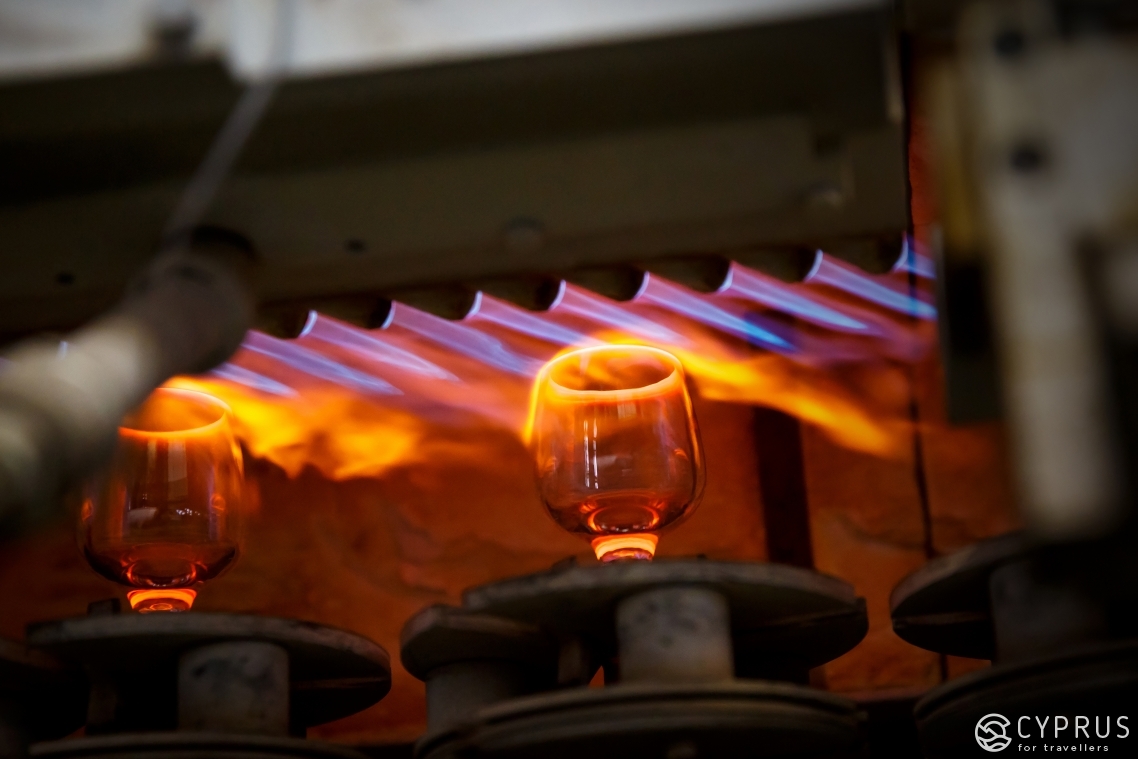
Glass is made in special furnaces at high temperatures: from 300 to 2500°C, while the process of glass formation begins once the temperature reaches 1200-1240°C. This material does not have a specific melting point (heat resistance to varying glass types may differ); it then turns into a liquid, gradually softening in the raised heat and transforming into a bright, homogenous mass. The sturdiest types are single quartz and pyrex glass (borosilicate) [4].
Several types of glass are made at very high temperatures, for their physical properties depend on chemical composition, melting conditions and subsequent processing.
Melted glass can be shaped by various methods. In addition, the melted mixture can be poured to achieve its shape — as well as other items, the majority of optical lenses are nowadays created by this means.
Glass blowing is a process which allows various round products — spheres, vases, wine glasses and others — to be obtained from a soft and viscous melted mixture. This occurs through the following method: a portion of red-hot melted glass is collected at the end of a hollow pipe with a ringlet or a bulb-shaped tip; the glass is then blown out and having cooled gains the consistency of caramel, while the pipe is turned to produce the desired shape and size.
By this means the item takes shape, thanks to the air blown into the pipe by the artisan, as well as gravity and instruments which a glass blower uses when working with molten glass (diamond cutters, scissors, pincers, screwdrivers and pontees).
To add colour, while the mass encompasses the tube, the glassblower quickly rotates it in coloured glass granules. As the glass is heated through the peep hole of a glass melting furnace, the coloured layer is melted repeatedly. It is then rolled out onto a block, in order to give it the initial form before it undergoes the blowing process: it is extremely important to constantly rotate the glass so it does not slack and stick together. If a glass blower manufactures laboratory instruments and apparatus components, their glass should possess high chemical and heat resistance, while simultaneously being easy to work with under a blowtorch flame. The final stage in glass making is the gradual cooling of the glass. The substance is placed into a kiln for 12 hours (to avoid cracks appearing), where it is cooled to a temperature of 250°C.
A note from the pros to those who are starting from scratch: never leave glass where it can be damaged by foreign objects or exposed to pollutants (dust, leaves, water and insects). Contact with cold objects may lead to crack formations. Upon completion the glass is covered, laminated or tended to by other means to raise its strength and durability.
- Annealing — this is where a glass item is completely heated in a furnace to a temperature at which the particles acquire mobility, but the glass does not soften. As professionals say: the less viscous the glass, the quicker the strain disappears. This process removes what are referred to as residual point sources, which often form in the cooling process, when the glass is still rather weak (they are determined with the aid of a polariscope. The processing temperature depends on the composition of the glass: 400-550°C. Before beginning, research is conducted on appropriate methods for annealing.
- Tempering — this is similar to the annealing process: the shaped and polished glass is placed into an oven and heated to no less than 600°C, after which it is quickly cooled (“tempered”) by an air current and exposed to high pressure.
Art Glass
I’d like to go into more detail about several processing types (techniques), which are well known all over the world.
The Everlasting Trend and Magnetism of Murano Glass
As centuries pass by and new technology is developed, the hand manufacture of interior decorative items and costume jewellery remains unchanged: items are still created by glass blowers with the aid of a special tube.
Genuine “Murano” glass (and this is a special, widely accepted term) can be distinguished by its particular consistency and smoothness, its external effect is reminiscent of jewellery wares and naturally coloured crystals. All of this is achieved by purifying the glass at numerous stages, adding gold or other metallic granules (for example, copper) to the feed, but also thanks to the multi-capability and sophistication of the tools used. One of the most popular methods in manufacturing Murano is known as the “crackle” technique — this involves creating a network of small cracks on the item’s surface after submerging it for a short period in cold water. If after submersion the glass is again placed in a furnace, small bubbles will begin to form inside — this method, known as “Pulegoso” produces an interesting creative effect.
Filigree glass (also “millefiori”) is also particularly eye-catching: it is made by interweaving “threads” of different colours deep in transparent glass. Mosaic glass (combinations of transparent and dense glass “barrels” in sets) with a coloured pattern, is widely used in the manufacture of costume jewellery (necklaces, rings and earrings). Curiously, this technique was invented sometime in Ancient Egypt, but in later centuries was adоpted by the Romans and developed thanks to Venetian glassblowers in the Renaissance era.
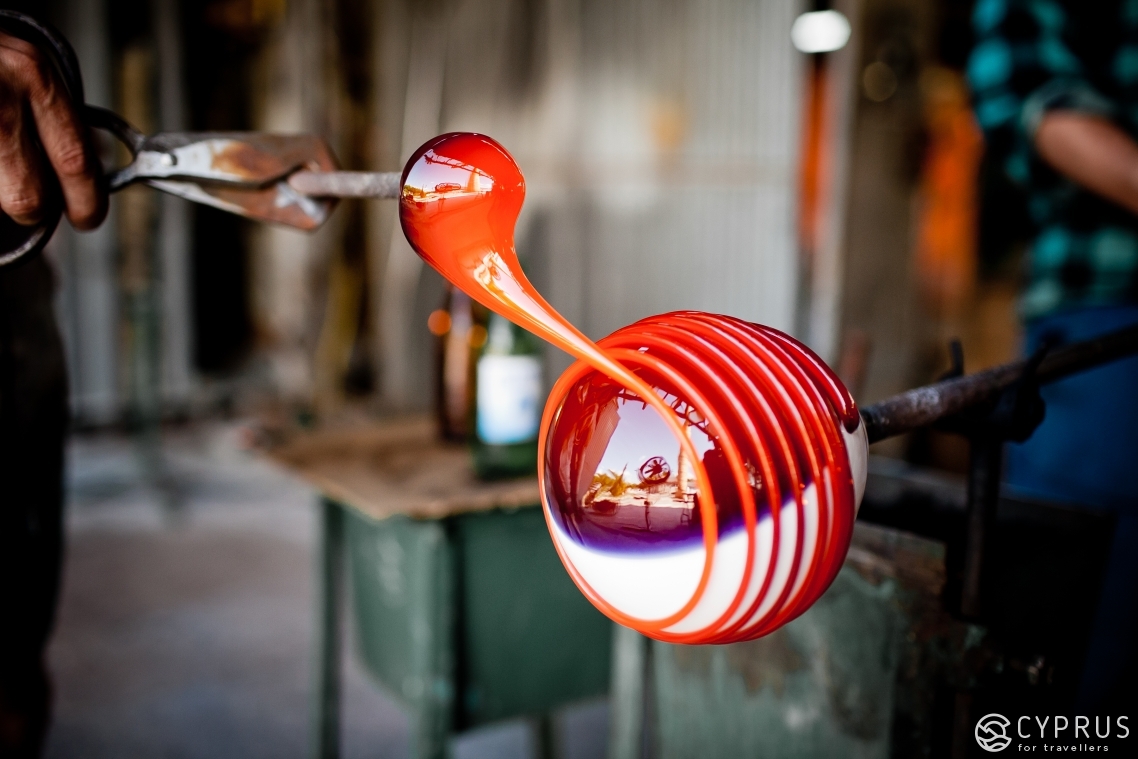
The Cost of the Question: How to Spot a Fake
Murano glass has always been of value and for this reason people have learnt to craft fake versions rather well. However, there are several characteristics which are only found in original pieces.
Firstly, Murano glass is smooth and transparent. With a light knock, a decorative piece will emit a crystal-clear sound. No seams will be visible on an original piece and they will always have at least some distinguishing features, since they are crafted by hand. Murano glass does not fade, nor does it become dull over time. All pieces have a trademark seal: in 1994 the association of glass producers Promovetro created and officially secured the “Vetro Artistico Murano” trademark for its products, thus protecting all original pieces.
And so, Murano glass is considered to be the most expensive in the world. Indeed, an interesting (and very beautiful) topic… however, during an interview with our new acquaintance, Andreas Dzhamalis, an talented artisan from Paphos, he claimed that Murano glass simply “doesn’t exist” as a special technique... (you can read about this and lots more in our coming interview with him).
-
It is worth mentioning that in the sphere of art glass-making, contemporary artisans only have access to low budget forms of glass work, such as fusing and torch work.
Fusing
The “fusing” techqnique (from the English fuse — “sintering, melting”) is the process in which glass elements compact and bind together at high temperatures, when all fragments and particles become homogenous and merge with one another. Glass which has been thermally processed in a furnace at high temperatures, ranging from 593°C to 816°C, is called melted (fused) glass.
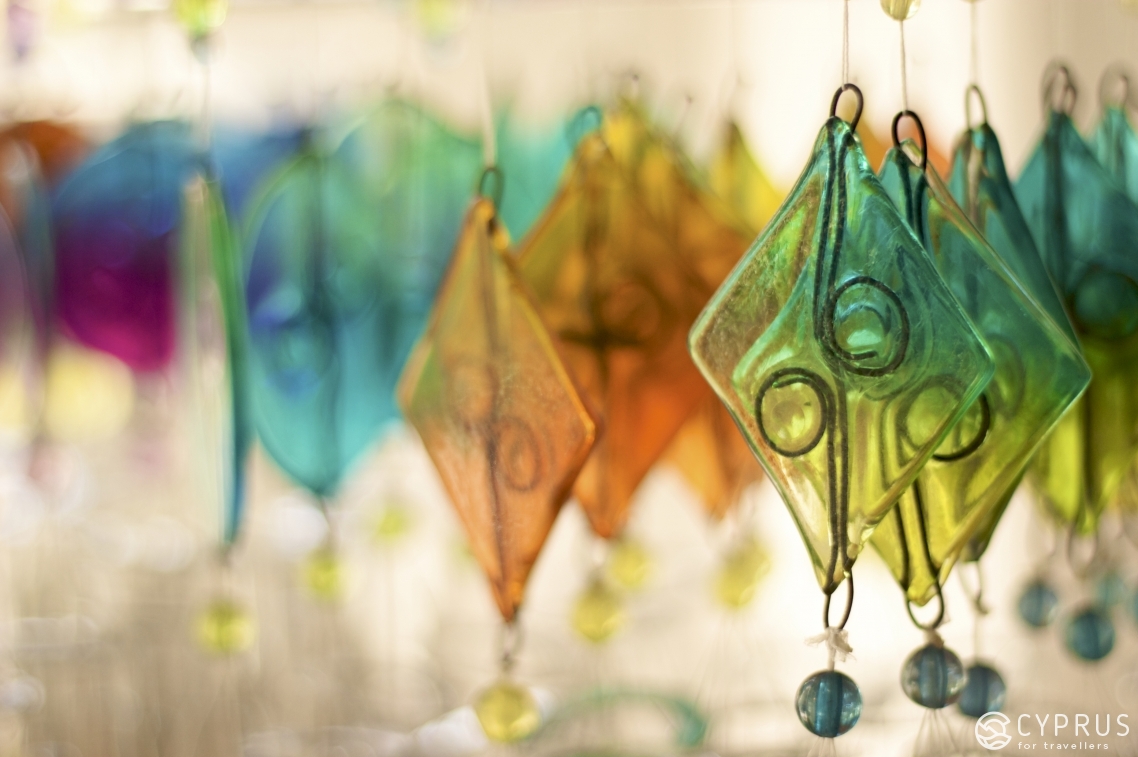
Three main heating levels exist, which provide varying effects: low (593-677°C), medium (677-732°C) and high (732-816°C) range melt temperatures. All these methods can be applied to one piece, giving it depth, relief and emphasising its shape.
In essence, this follows the same paradigm as the stained glass technique; however, in contrast to stained glass, it has no concise borders between its elements; rather the opposite, — it aims to erase these borders and achieve the smooth transfer of the elements into each other. With the aid of an oil-fed glass cutter, the craftsmen cuts out fragments from slices of special glass, and uses various types of forceps to “chip off” the necessary sized pieces during the course of his work. If you also decide to try your hand at applied arts, then stock up on a grinding machine, PVA glue, spades and rulers.
At first glance the concept is rather simple: you assemble your future composition on a sheet of glass: pattern elements are cut out from coloured glass pieces, polished and then stuck to the main piece with PVA glue (when melted the glue will fade, leaving no traces). The item is then sent to the furnace for fusing, where it is heated for 5-6 hours at 700°C.
Fusing, for instance, enables the creation of multi layered stained glass, which is embossed and even more emphasised. In contrast to classical stained glass, when the glass elements have gathered into a lead frame, which has been sealed along its joints, fused glass panels do not have seams between their elements. The use of such treatment to the glass allows for the creation of artistic pieces insusceptible to dimming and the effects of time, with unique manners of execution and the widest colour spectrum.
For around 2000 years, fusing has been the main method for manufacturing small glass items. Despite glass manufacture on the whole experiencing a rebirth in the Renaissance era, the fusing technique was by and large ignored during this period.
It began to gain popularity at the start of the 20th century, particular in 1960s USA; yet this type of decorative applied art, as well as being a wonderful and fascinating hobby, has experienced a genuine boom in the present day.
On YouTube you can now find a multitude of videoclips, such as this master class in creating murals by sintering pieces, which are cut out from sheets of special glass of various colours, for fusing and crushed fragments.
Torch Work
This is a famous type of artistic glass processing with a blowtorch, known in English as torch work or flame work. This method is used for the creation of small decorations and decorative items with the help of a manual blowtorch or portable electric furnace.
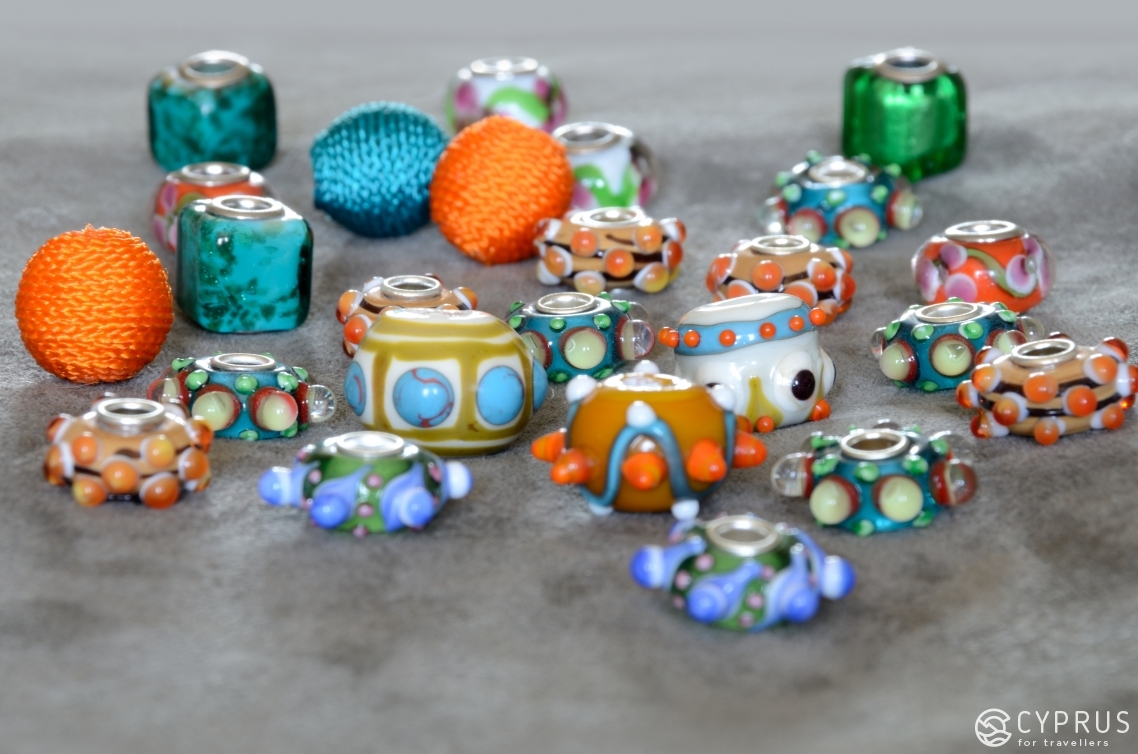
By the way, for novices, usual beads and bottles can serve as a makeshift material for practice use.
A torch worker (or a person with a blowtorch and protective goggles; — you will also be called this if you get into it) inserts a glass rod — “a first timer” (or several at an advanced level) of a specific colour into a propane-air, oxygen, hydrogen or plasma flame. The glass melts, thus creating a mould which can be added to with the inclusion of various colours, in order to achieve the desired effect. A fragment of the melted glass from the fire (a bead) is placed on a mandrel and constantly turned with a graphite spade and then forceps (or scissors) to give it shape: upon completion, each component is set up to be at the end of the torch’s flame… in order to make it simpler to attach the next one.
A torch worker not only works with glass, but with a torch, changing the strength of the flame and thus the effect achieved in his work. The artist adds the most meticulous details with the end of a heated metal rod stretched with pincers into a stringer needle. The finished product is then placed in a ceramic blanket or a furnace for around 8 hours. If you create a ring from glass, then the coloured layer, with possible impurities (for instance, glass granules — frit), will need to be covered with a layer of colourless glass.
The temperature necessary for working with glass — 700-1200°C — is dependent on the glass manufacturer.
The glass used in a particular piece of work must have an identical coefficient of expansion, with the most frequently used being «Moretti/Effetre» from Murano island.
You can observe a similar example here.
Nowadays, in many countries, there are also craftsmen who work in the manufacture of fused glass. For instance, there are several workshops in Russia offering contemporary fusion designs (in Yekaterinburg, Moscow and other cities).
In this art and with its use, the most diverse items are created in these Russian art workshops: clocks (both for walls and desks), stained glass windows, murals, jewellery, mirror or photograph frames, elements of glazed tiles, flower pots, dishes, sweet boxes and others.
Folk Glass Painting in Cyprus
Since the beginning of the 20th century, this art has been widespread in Messaoria, and was long a key element in the hall decor of a traditional home in the region. Both men and women had command of this skill and would create various items with topics displaying religious themes, national heroics (Constantine Palaiologos and Alexander of Macedon, famous heroes and battle scenes from the 1821 Greek revolution) and those inspired by myth (mythical animals and birds or motifs). Household images of people (fellow villagers from couple and family photos) were also displayed, as well as fables and epigrams, written in calligraphy.
Oil was applied to the glass surface on the reverse side of paintings with bright colours, done in a simple folk style, as though by stencil (concerning the photographs).
As such, the dominant colours in glass painting — red, dark blue, orange, green and yellow — were similar to those traditionally used in other crafts on the island: weaving, painting carved wooden items and in the decor of woven mats and baskets.
Interestingly, despite specifically acknowledged conventions, artists were rather free in terms of self expression.
Back then, genuinely talented people appeared in this circle of folk artists, one such example was the famous Cypriot artist, Michalis Kashalos from the village of Asha in Messaoria.
At the very start of his career, he only painted “glass”, a decoration favoured by folk for use in Messaoria’s so called “Dikhoro” — living rooms, which he never autographed, in contrast to his other artisan colleagues. Like him, artists were occasionally inspired not only by images from church icons and family hall photos, but by pictures from fashion magazines and the advert booklets of those years, which were circulated between fellow villagers; and of course, the patterns of local embroidery.
The Main Manufacturers of Glass (Construction and Household) in Cyrpus
Metalco Glazing ltd have been glazing new buildings in Nicosia almost non stop since 1944.
(+357 22492944, +357 22492250, www.metalcoglazing.com.cy)
Shikkis Glass Processors (+357 24823099, + 357 24531277, www.shikkisglass.com) is a family run business, which was founded in 1992 in Larnaca. It is the largest company in Cyrpus for processing glass in construction and the decorative industry. Based on automatisation, the most progressive technology and qualified personnel, the firm offers its clients a diverse range of services and new products accessible on the “glass market” from glass stairwells, doors, windows for homes and shops, to stained glass windows, mirrors and fused glass.
Glass Art Studios in Cyrpus:
The Place: the studio has a diverse range of items (from frames and decorative dishes to decorations and souvenirs) on sale, both ready made and to order, all of which have been crafted by Andreas Djamalis.
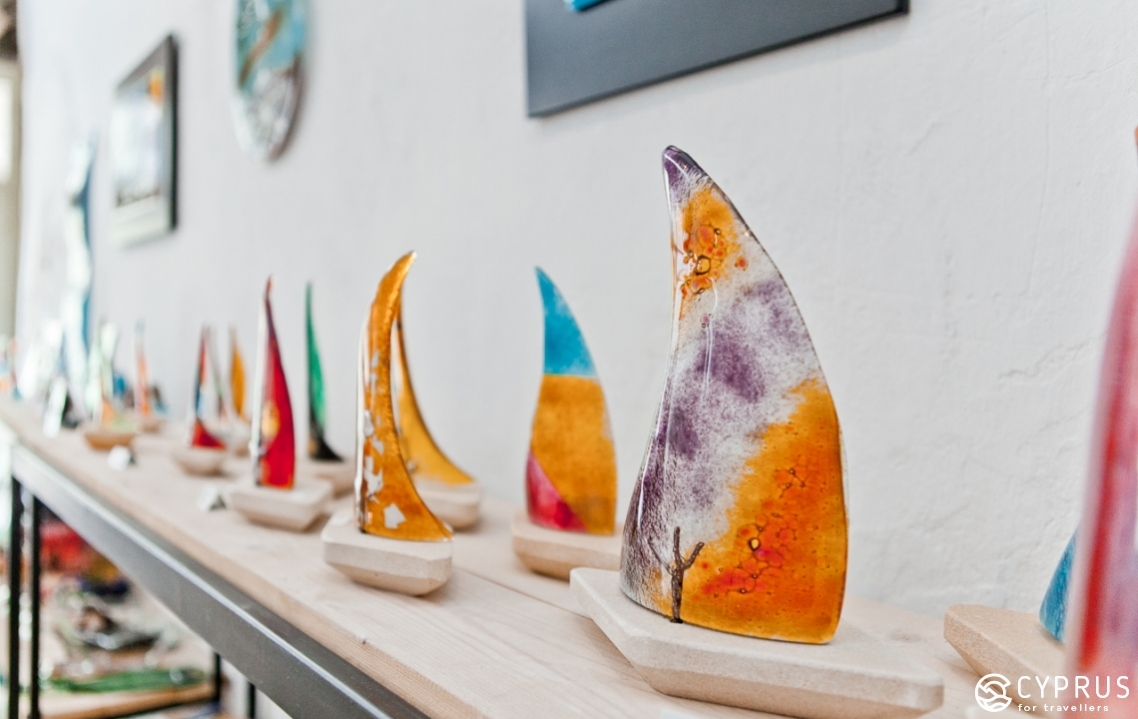
Welbry Art & Glass, stained glass studio (62, Vasiliou Makedonos, Limassol).
Master — John Welch. The workshop creates fused items, traditional stained glass windows, lamps and mirrors.
For those who wish to learn, he provides lessons in all the well known techniques.
You can get everything you need to take this up as a hobby from the studio: glass, different materials and instruments.
If you wish to know how decorative glass is produced in Cyprus (stained and fused glass), see here: the studio of Maria Voniatu Tsomparta (interview in Greek).
Incidentally, among the most popular island souvenirs, many guides recommend bringing home different glassware, which can be an excellent gift.
They can be found on numerous souvenir stalls, in art shops and galleries, and of course, in folk art shops.
Approximate prices: a glass statue — from 2 Euros; a pint glass — from 4 Euros; a decanter — from 5-7 Euros.

But souvenirs will be souvenirs, for after all, you can make a lot with your own hands.
Now that the time for our handmade wares has arrived, and manually creating glass by well known techniques is too much to handle for novices without any special equipment or preparation, then why not do some decorating?
Today, I suggest trying to make an elegant mural (or some stained glass, a screen, the glass door of a shopping counter — or whatever you want) in an art nouveau style a la Louis Comfort Tiffany (1848-1933).
With Your Own Hands: A Tiffany Mural
Please note: it isn’t easy to make these patterns, therefore you ought to work in stages, creating the decor in fragments.
So, purchase a sheet of glass (you will need to ask the master to smoothen the sharp edges, so you do not injure yourself).
We will also need: stained glass paints (various colours, including pearl-white), a №2 brush, adhesive tape, black outliner and a template (you can make this yourself on any art nouveau/modern picture, enlarged to the necessary size.
We will suggest our options.
Instructions:
Place the glass sheet on the prepared template and attach them together with adhesive tape.
With the black outliner, go round the template drawing on the glass. Wait for several hours so the paint has time to dry.
Apply the coloured paint [5], having diluted it in water beforehand (or with a solvent), then follow the previous step.
A word of advice: you cannot just simply “paint” segments with any given colour. Try playing with it: over the monotone background you could apply different colours, contrasting spots, and shades to brighten the work etc.
Fill in the gaps with a colourless stained lacquer (it’s not worth diluting it, but immediately squeeze it out of the tube onto the surface), — this will add lightness and openness to the pattern.
Give all the paints a good chance to dry out.
Before putting your mural into a frame (window or door), for best preservation cover your finished work with another sheet of ordinary glass and bond them together with silicon glue.
Good Luck!
Stay with us and see you soon!

[1] Today it is kept in the Berlin museum, as one of the most ancient samples of glassware in the world.
[2] Scientists determined: the Egyptians melted glass on open hearths in ceramic basins. The red hot slabs were thrown into water: they would crack and split into pieces — frits, which were then ground on millstones and melted again.
[3] Synthetic inorganic glass is a supercooled melted mixture, the composition of which contains oxides of silicon, boron and phosphorus, as well as alkaline and alkaline earth metals.
[4] This glass type was patented in 1915-1919 by Sullivan and Taylor, employees of the firm “Corning”, but “pyrex” glass ultimately found widespread distribution in many countries of the world, under various names. This glass type possesses high chemical resistance, with regards to water and acids. Processing such glass in the flame of a glass blower’s torch requires a high temperature of 800°С.
[5] Acrylic paint is easier to use as it can be dissolved in water. Increasing the dye’s resistance aids in the heating process. The finished product is placed in the oven, where it is heated at a temperature of 150-170 degrees. That being said, solvent based paints are stronger: they do not scuff, wash off or dim… and they’re also brighter.

